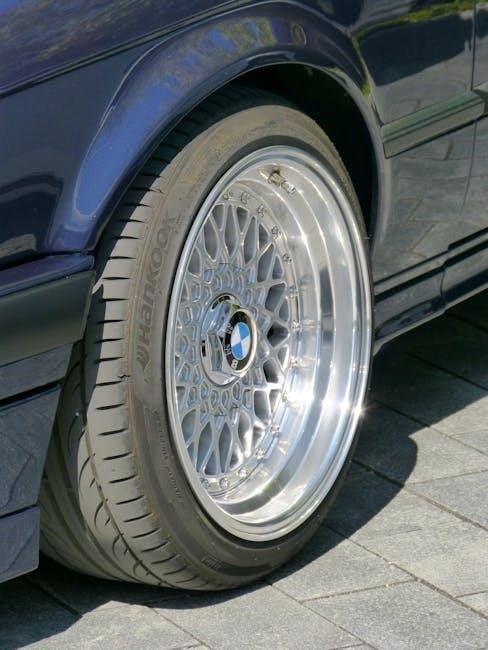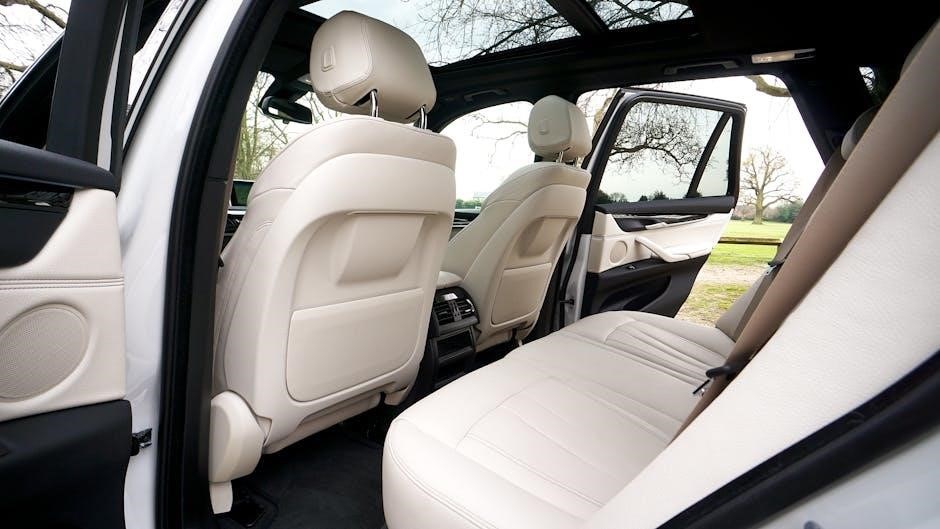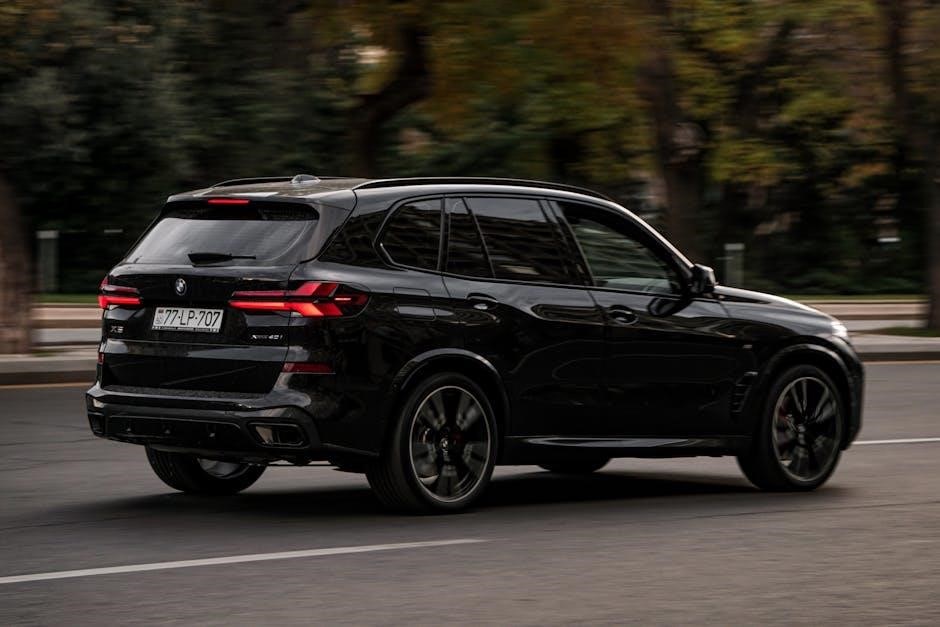
Welcome to the ultimate BMW X5 Buyer’s Guide, your comprehensive resource for navigating the purchase of this luxury mid-size SUV. From its debut in 1999, the BMW X5 has captivated families and enthusiasts alike with its blend of luxury, performance, and versatility. This guide covers generations, features, and expert tips to ensure a well-informed decision.
Overview of the BMW X5
The BMW X5 is a luxury mid-size SUV that has been a favorite among car enthusiasts and families since its debut in 1999. Known for its exceptional blend of luxury, performance, and versatility, the X5 combines the agility of a BMW sedan with the practicality of an SUV. Over the years, it has evolved through multiple generations, each offering advancements in technology, design, and capability. Whether you’re seeking a powerful engine, advanced safety features, or a premium interior, the X5 caters to a wide range of needs. Its popularity endures as a top choice for those who value both comfort and driving dynamics in a refined package.
Understanding the Target Audience
The BMW X5 appeals to a diverse audience, including families, professionals, and car enthusiasts. Families are drawn to its spacious interior, safety features, and versatility, making it ideal for daily use and long trips. Professionals appreciate its luxurious design, advanced technology, and the prestige associated with the BMW brand. Enthusiasts, on the other hand, value its powerful engine options, precise handling, and the option for high-performance M variants. Additionally, eco-conscious buyers may consider hybrid models like the X5 xDrive45e, which offers a balance of power and efficiency. This broad appeal ensures the X5 remains a top choice across various demographics and preferences.

BMW X5 Generations: A Detailed Overview
The BMW X5 has evolved through four generations: E53 (1999-2006), E70 (2006-2013), F15 (2013-2018), and G05 (2018-present). Each generation introduced enhanced features, design improvements, and performance upgrades, catering to evolving consumer demands and technological advancements.
E53 Generation (1999-2006)

The E53 generation marked the debut of the BMW X5, introducing the brand’s first SUV. Produced from 1999 to 2006, it combined sporty dynamics with off-road capability, appealing to a new market. The E53 featured a robust design with a tall stance and aggressive lines, setting the foundation for future X5 models. It offered a range of engines, including inline-6 and V8 options, providing strong performance for its class. The interior was functional yet luxurious, with premium materials and ergonomic controls. This generation established the X5 as a pioneer in the luxury SUV segment, blending BMW’s driving heritage with practicality.
E70 Generation (2006-2013)
The E70 generation, produced from 2006 to 2013, marked a significant evolution for the BMW X5. It featured a larger and more angular design compared to its predecessor, with improved interior space and luxury. The E70 introduced BMW’s iDrive system, enhancing infotainment and connectivity. Engine options included inline-6, V8, and diesel variants, offering a balance of power and efficiency. The xDrive all-wheel-drive system was refined, providing superior traction and stability. This generation also saw advancements in safety, with features like adaptive cruise control and lane departure warning. The E70 remains popular for its blend of performance, comfort, and versatility, making it a strong contender in the used luxury SUV market.
F15 Generation (2013-2018)
The F15 generation, produced from 2013 to 2018, brought a more aggressive and modern design to the BMW X5. It featured a revised front grille, sharper lines, and a more luxurious interior. This generation introduced the use of lightweight materials, improving fuel efficiency and handling. Engine options expanded to include a four-cylinder diesel, while the xDrive50i model boasted a powerful V8. The F15 also saw advancements in technology, such as LED adaptive headlights and an updated iDrive system. Ride comfort and performance were refined, making it a well-rounded choice for both on-road driving and light off-road adventures. This generation solidified the X5’s reputation as a premium SUV.
G05 Generation (2018-Present)
The G05 generation, launched in 2018, marked a significant redesign for the BMW X5, blending luxury with off-road capability. It features a more angular exterior design, including a larger kidney grille and slimmer LED headlights. Inside, the X5 offers a modern cockpit with a 12.3-inch infotainment screen and a digital instrument cluster. Engine options include inline-4, inline-6, and V8 choices, with plug-in hybrid variants introduced later. The G05 also boasts improved suspension systems, enhancing both on-road comfort and off-road prowess. Advanced safety features like adaptive cruise control and lane-keeping assist were added, making it a tech-forward SUV. This generation continues to redefine the X5 as a leader in its class, combining performance, luxury, and versatility.
X5 M Variants
The BMW X5 M represents the pinnacle of performance in the X5 lineup, engineered by BMW’s M division. First introduced in 2009, the X5 M combines SUV practicality with track-ready capabilities; The current G05-based X5 M features a potent 4.4L twin-turbo V8, delivering over 600 horsepower and 553 lb-ft of torque. It accelerates from 0-60 mph in just 3.8 seconds. Exclusive features include an M-tuned suspension, sport exhaust, and aerodynamic styling. The Competition variant offers even more power and aggressive styling. With adaptive dampers and rear-biased xDrive, it balances daily usability with thrilling dynamics. For enthusiasts seeking a high-performance SUV, the X5 M is a standout choice.

Key Features and Technologies
The BMW X5 showcases a blend of luxury, performance, and innovation, featuring advanced driver-assistance systems, a premium infotainment setup, and cutting-edge safety technologies for enhanced driving experiences.
Exterior and Interior Design
The BMW X5 boasts a striking exterior with a muscular yet elegant design, featuring a prominent kidney grille, sharp lines, and adaptive LED headlights for a modern appeal. Inside, the cabin offers luxury and functionality, with premium materials like leather upholstery and wood trim. The spacious interior accommodates five passengers comfortably, with optional third-row seating for added versatility. A panoramic moonroof enhances natural light, while the driver-centric cockpit ensures an intuitive and immersive driving experience. The X5’s design balances sophistication and practicality, making it a standout in its class.
Performance and Engine Options
The BMW X5 offers a range of powerful and efficient engine options, catering to diverse driving preferences. The base model typically features a 3.0-liter turbocharged inline-6 cylinder engine, delivering smooth acceleration and ample torque. For higher performance, a 4.4-liter twin-turbo V8 engine is available, providing exceptional power and responsiveness. A plug-in hybrid variant combines a turbocharged engine with an electric motor, offering improved fuel efficiency without compromising performance. All models come with an 8-speed automatic transmission and BMW’s xDrive all-wheel-drive system, ensuring precise handling and stability. Optional adaptive suspension further enhances the driving experience, making the X5 a versatile choice for both on-road comfort and off-road capability.
Safety Features
The BMW X5 is equipped with an array of advanced safety features, ensuring a secure driving experience. Standard safety technologies include multiple airbags, collision warning systems, and lane departure warning. Adaptive cruise control with stop-and-go functionality is available, enhancing comfort and safety on highways. Parking sensors and a 360-degree camera system provide exceptional visibility during low-speed maneuvers. The X5 also features BMW’s Active Guard Plus, which includes automatic emergency braking and pedestrian detection. Its robust body structure and high-strength materials contribute to excellent crashworthiness, earning it top safety ratings. These features make the X5 a reliable choice for families and drivers prioritizing safety.
Interior Technology
The BMW X5 boasts a state-of-the-art interior equipped with cutting-edge technology. The centerpiece is the iDrive infotainment system, featuring a high-resolution touchscreen display with intuitive controls. Voice command functionality allows seamless interaction with navigation, climate, and entertainment systems. Wireless Apple CarPlay and Android Auto ensure smartphone integration, while a Wi-Fi hotspot keeps everyone connected. A digital instrument cluster provides customizable driver information, and optional gesture controls add a futuristic touch. Premium audio systems, including Harman Kardon or Bowers & Wilkins options, deliver exceptional sound quality. Additional features like a panoramic moonroof and ambient lighting enhance the cabin experience, making the X5 a blend of luxury and innovation.
Fuel Efficiency
The BMW X5 offers a range of engine options with varying fuel efficiency. The base model typically achieves around 23 mpg in the city and 28 mpg on the highway, while higher-performance variants may have slightly lower ratings. Hybrid models, such as the xDrive45e, provide improved efficiency with an estimated 31 mpg combined and up to 31 miles of electric-only range. The xDrive50i, with its powerful V8, sacrifices some efficiency but still manages decent mileage for its class. Fuel efficiency varies by generation, with newer models benefiting from advanced technologies like start/stop systems and aerodynamic improvements. Comparing different trims and model years can help buyers find the balance between performance and efficiency that suits their needs. Regular maintenance also plays a key role in optimizing fuel economy.
Storage Capacity
The BMW X5 offers ample cargo space, making it practical for daily use and adventures. With the rear seats up, it provides approximately 33.9 cubic feet of cargo space, expanding to 72.3 cubic feet when the seats are folded. The 40:20:40 split-folding rear seats add versatility, allowing for flexible cargo and passenger configurations. Additional storage options include under-floor compartments and cargo nets for securing items. Hybrid models may have slightly reduced cargo space due to battery placement. The X5 balances luxury with functionality, catering to both small and large storage needs. This makes it an excellent choice for families, road trips, or outdoor enthusiasts seeking a blend of style and practicality.

The Buying Process
The BMW X5 buying process involves researching models, comparing trims, test driving, securing financing, and negotiating terms to ensure a smooth and informed purchase experience.
Setting a Budget
Setting a budget is crucial when purchasing a BMW X5 to ensure financial stability. Consider the purchase price, financing costs, insurance, and maintenance expenses. New X5 models range from $60,000 to over $100,000, while used models start at around $15,000 for older generations. Allocate 10-15% of the vehicle’s price for a down payment and evaluate loan terms carefully. Avoid stretching your budget too thin, as it may lead to financial strain. Assess your income, savings, and monthly expenses to determine a comfortable price range. Prioritize needs over wants, such as optional features, to stay within your means. A well-planned budget ensures a stress-free ownership experience.
New vs. Used: Pros and Cons
Purchasing a new BMW X5 offers the latest technology, superior performance, and a comprehensive warranty, providing peace of mind. Buyers can also customize their vehicle to their preferences. However, new models come with a higher price tag and rapid depreciation. On the other hand, used X5s are more affordable and have already taken their biggest depreciation hit. Certified pre-owned (CPO) models provide added assurance with inspections and extended warranties. Yet, used cars may lack the newest features and could require higher maintenance costs. Weighing these factors helps buyers decide whether a new or used X5 aligns best with their budget and needs.
Choosing the Right Trim Level
Selecting the appropriate trim level for your BMW X5 is crucial to meeting your needs and preferences. The base model offers essential features like leather upholstery and an advanced infotainment system. The xDrive40i adds a powerful engine, while the xDrive50i provides enhanced performance. The M50i combines luxury with sporty dynamics, and the X5 M delivers high-performance capabilities. Consider your budget, lifestyle, and priorities. If luxury is key, higher trims offer premium materials and advanced tech. For performance enthusiasts, the M variants are ideal. Compare features and test drive models to ensure the chosen trim aligns with your driving habits and expectations.
Financing Options
Exploring financing options is essential for acquiring a BMW X5. Buyers can opt for traditional auto loans, which provide ownership upon full payment. Leasing is another option, offering lower monthly payments and the flexibility to return the vehicle after the lease term; BMW Financial Services offers tailored plans, including competitive interest rates and flexible terms. Additionally, certified pre-owned (CPO) vehicles may qualify for special financing programs. It’s important to compare lenders, consider down payments, and review annual percentage rates (APR). Consulting with a financial advisor or dealership can help identify the most suitable financing solution. Always review the total cost of ownership before finalizing a decision.

Pre-Purchase Inspection Checklist
A thorough pre-purchase inspection ensures the BMW X5 is in optimal condition. Check the exterior for dents, rust, and proper alignment. Inspect the interior for wear, functionality, and odors. Evaluate engine performance, transmission smoothness, and drivetrain stability. Examine suspension for leaks and tires for even tread. Review service records and test drive to identify any issues. Ensure all safety features and technologies are operational. Addressing these steps helps avoid costly surprises post-purchase.
Exterior Inspection
Begin with a thorough walk-around to assess the BMW X5’s exterior condition. Check for dents, scratches, or rust on the body panels, paying attention to areas prone to damage. Inspect the paint finish for consistency and signs of repainting. Examine the bumper and trim for alignment and damage. Verify the condition of alloy wheels, ensuring they are free from curb damage or excessive wear. Tires should have even tread depth and proper inflation. Check for any cracks or chips in the windshield and windows. Test door handles, mirrors, and roof rails for functionality. Ensure the exhaust system is free from damage or leaks. Look for any signs of suspension issues, such as uneven tire wear or sagging. Addressing these points ensures the exterior is in good shape.
Interior Inspection
Examine the interior for signs of wear or damage. Check the upholstery for tears, stains, or excessive wear on seats, especially the driver’s seat. Test all electrical features, including the infotainment system, climate control, and heated or ventilated seats. Ensure the dashboard and trim are free from cracks or fading. Inspect the carpets and floor mats for dirt or water damage. Look for any unusual odors, which could indicate moisture issues. Verify that all buttons, knobs, and switches function properly. Check the glove compartment, center console, and door pockets for damage. Test the rear seats for folding functionality and ensure the rear cargo area is clean and undamaged. Addressing these points ensures the interior is in good condition.
Engine and Performance Check
Inspect the engine bay for any signs of leaks, damage, or excessive wear. Check the oil and coolant levels, ensuring they are at recommended levels and free from contamination. Look for any signs of overheating, such as cracked hoses or a malfunctioning radiator. Test the engine’s performance by starting it cold and listening for unusual noises or vibrations. Accelerate smoothly to assess power delivery and responsiveness. Check for any warning lights on the dashboard that may indicate engine issues. Review maintenance records to ensure regular servicing has been performed. Consider hiring a mechanic to inspect the engine and transmission for hidden problems. A well-maintained engine ensures reliability and optimal performance.
Transmission and Drivetrain
When evaluating the BMW X5, inspect the transmission for smooth shifting and responsiveness. Check for any signs of leaks or damage to the drivetrain components. Test drive the vehicle to ensure seamless gear transitions and proper operation of the xDrive all-wheel-drive system. Review maintenance records to confirm timely fluid changes and inspections. Look for any error codes related to the transmission or drivetrain using diagnostic tools; Pay attention to unusual noises or vibrations during acceleration, as these could indicate issues. The X5’s drivetrain is designed for agility and traction, so ensure it performs as expected in various driving conditions. A well-maintained transmission and drivetrain are critical for long-term reliability and performance.
Suspension and Tires
Inspect the BMW X5’s suspension for any signs of damage, wear, or leaks. Check the condition of the tires, including tread depth and even wear patterns. Uneven wear may indicate misalignment or suspension issues. Test the ride quality by driving on smooth and uneven surfaces to ensure the suspension absorbs shocks effectively. Verify the tire pressure matches the recommended levels for optimal performance and safety. Review maintenance records for any recent alignments or suspension repairs. The X5’s adaptive suspension systems, like Dynamic Damper Control, should provide a smooth ride and responsive handling. Ensure all tires are of the same type and size, and consider the age of the tires, even if tread is sufficient.

Maintenance and Cost Considerations
Regular maintenance is crucial for the BMW X5’s performance and longevity. Consider service intervals, genuine parts costs, and fuel efficiency. Budgeting for ongoing expenses ensures reliability.
Routine Maintenance Schedule
Adhering to a routine maintenance schedule is essential for the BMW X5 to ensure optimal performance and prevent costly repairs. Typically, BMW recommends oil changes every 5,000 to 7,500 miles, depending on driving conditions. Tire rotations should occur every 6,000 to 8,000 miles to maintain even wear. Brake inspections are advised every 12,000 miles, while fluid checks and replacements for coolant, transmission, and differential should follow the intervals outlined in the owner’s manual. Additionally, spark plugs may need replacement around 60,000 miles. Staying on top of these schedules helps preserve the vehicle’s longevity and resale value. Always consult a certified BMW service center for precise recommendations tailored to your driving habits.
Common Issues to Watch For
When considering a BMW X5, it’s important to be aware of common issues that may arise, particularly in older models. The E53 and E70 generations often experience problems with the transfer case and coolant leaks, which can lead to costly repairs if neglected. The F15 and G05 models have reported issues with the engine’s valve cover gasket and high-pressure fuel pump failure. Additionally, rear differential seal leaks are a recurring problem across multiple generations. Buyers should also inspect for excessive wear on suspension components and potential electrical system glitches. Addressing these issues early can help avoid larger problems down the road. Always review service records and consider a pre-purchase inspection.
Repair and Replacement Costs
BMW X5 repair and replacement costs can be significant due to its luxury and complex engineering. Parts like engine components, transmissions, and suspension systems are pricey, with costs ranging from $500 to $5,000 or more, depending on the issue. Genuine BMW parts are typically more expensive than aftermarket alternatives. For instance, a replacement engine can cost between $8,000 and $15,000, while a new transmission may range from $4,000 to $8,000. Brake systems and advanced electronics also carry higher price tags. Regular maintenance can help prevent costly repairs, but unexpected issues may still arise. Buyers should budget for potential expenses and consider extended warranties or certified pre-owned options to mitigate costs.

Test Drive Tips
Evaluate driving dynamics, comfort, and technology during the test drive to ensure the BMW X5 meets your expectations for performance and daily usability.
What to Look For During a Test Drive
During the test drive, pay attention to the BMW X5’s acceleration, steering responsiveness, and handling on various road surfaces. Check for smooth gear shifts and braking performance. Assess cabin noise levels at different speeds to ensure it meets your comfort expectations. Evaluate the functionality of the infotainment system and ease of use for controls like climate settings and driver-assistance features. Test the comfort of the seats over an extended drive and ensure proper visibility from the driver’s seat. Additionally, check how the vehicle handles tight spaces and parking maneuvers, as well as the responsiveness of the parking sensors and camera systems.

Post-Purchase Care
- Regularly schedule maintenance as per BMW’s service intervals to ensure optimal performance.
- Check fluid levels, tire pressure, and battery health periodically.
- Use genuine BMW parts for replacements to maintain reliability and warranty validity.
- Understand and utilize the vehicle’s warranty for covered repairs.
Proper care extends the BMW X5’s lifespan and retains its resale value.
Initial Maintenance After Purchase
After purchasing your BMW X5, it’s essential to perform initial maintenance to ensure optimal performance and longevity.
- Schedule a thorough inspection by a certified BMW technician to identify any potential issues.
- Check and top off all fluid levels, including oil, coolant, and transmission fluid.
- Replace the oil with synthetic oil recommended by BMW for improved engine performance.
- Inspect the tires for proper pressure, tread depth, and alignment.
- Review and update the vehicle’s infotainment system to the latest software version.
- Check the brake pads and rotors for wear and tear.
Addressing these maintenance tasks early ensures a smooth driving experience and prevents costly repairs down the line.
The BMW X5 offers a blend of luxury, performance, and versatility, making it a top choice for SUV enthusiasts. Proper research and maintenance ensure long-term satisfaction.
Final Thoughts

The BMW X5 is a well-rounded luxury SUV that excels in performance, comfort, and technology. Its versatility makes it ideal for both families and enthusiasts. Whether you prefer the raw power of the X5 M or the practicality of the base models, there’s an X5 for every need. Buyers should prioritize test drives and thorough inspections to find the right fit. Long-term satisfaction hinges on proper maintenance and understanding the costs involved. With its reputation for reliability and BMW’s commitment to innovation, the X5 remains a smart investment for those seeking a premium driving experience. It’s a decision you won’t regret.
Additional Resources
For further research, BMW’s official website offers detailed specifications and configurators. Forums like Bimmerforums and X5World provide real-owner insights and troubleshooting tips. Review sites such as Edmunds and Kelley Blue Book offer unbiased evaluations. Dealerships often provide brochures and test drive opportunities. Additionally, tools like TrueCar can help assess market pricing. YouTube channels specializing in automotive reviews, such as CarWow or Doug DeMuro, offer in-depth analyses. These resources ensure buyers make informed decisions. Utilizing these will enhance your understanding and confidence in selecting the right BMW X5 for your needs.